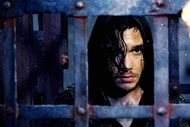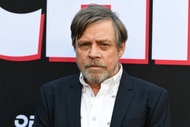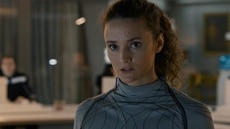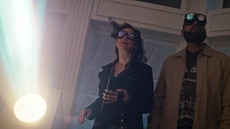The 20 greatest threequels ever made

Threequels are cursed. Or at least, they seem to be.
Hollywood often subsists on sequels to lucrative franchises, but it’s typically better at making Part 2 than it is at making Part 3. For every Star Trek II: The Wrath of Khan or The Dark Knight, there’s a Superman III or [cringe] X-Men: The Last Stand.
Threequel-itis is a thing, but Bill & Ted Face the Music is a recent threequel that doesn’t suffer from it. In fact, this third chapter is arguably the Bill & Ted franchise’s crowning achievement. As Bill and Ted’s latest time-traveling adventure earns rave reviews from both critics and fans, here are a few more must-see threequels (in order of release) that prove the “rule of threes” doesn’t always spell doom.
Goldfinger (1964)
Perhaps it's only proper that the Bond film about a villain with a fetish for gold would become the gold standard by which all other Bond movies are judged. Sean Connery’s third Bond movie establishes the franchise’s tried-and-true formula with everything from Bond staring down that iconic laser torture device to Oddjob and his spinning hat of death.
This is where Connery reached the peak of his rugged appeal as 007, which explains why many fans still consider him to be the definitive James Bond.
Star Wars: Episode VI - Return of the Jedi (1983)
The capper to George Lucas’ original Star Wars trilogy centers on Luke and Vader’s complicated (at best) father-son relationship as the two literally duke it out while the fate of the galaxy hangs in the balance. The build-up to the Skywalkers’ moody, all-out lightsaber brawl includes some of the franchise’s most iconic moments — like rescuing Han Solo from Jabba’s palace, Ewoks(!), the revelation that Luke and Leia are siblings, and the introduction of the villainous Emperor Palpatine.
Return of the Jedi also features one of the best finales in sci-fi history, as Rebel ships engage Imperial fighters in the epic Battle of Endor as Luke clashes with his dad (and gets zapped with Force Lightning) in the Emperor’s throne room aboard the second Death Star.
Star Trek III: The Search for Spock (1984)
The best of the original crew’s odd-numbered Treks, Star Trek III: The Search for Spock features some of the franchise’s most emotional moments, as Kirk endures the death of his son and the destruction of his ship, the Enterprise, in order to save his resurrected friend, Spock, from the clutches of “Klingon bastards.”
Leonard Nimoy's feature-film directorial debut gets a bad rap for its less-than-inspired cinematography and low production values. But Search for Spock has aged better than recent Star Trek films, thanks to its character-first, emotionally-resonate storytelling.
Nightmare on Elm Street 3: Dream Warriors (1987)
One of the greatest and most successful horror movie sequels ever made, Nightmare on Elm Street 3 is a fan-favorite that delivers all the chills of the first film but in new, exciting ways.
Dream Warriors made Freddy, well, Freddy — investing the killer with his trademark snark and sass as the character rose in popularity. Director Chuck Russell, working from a script co-written by Wes Craven and Frank Darabont, pushed the Elm Street concept into scariest territory by having Freddy use the dreams of his victims against them. Whatever their fears or passions, Freddy would weaponize them and use them as his killing ground — like when he turned a kid who makes puppets into a grotesque human marionette. The nightmare fuel is balanced out with a solid dose of humor, with the latter becoming a staple of future films for years to come. This threequel proved that horror sequels can do more than up the body count; they can, and should, raise the bar with their ambitions and not be afraid to push the genre to scarier, more dynamic, places.
Indiana Jones and the Last Crusade (1989)
James Bond and Indiana Jones deserve each other in Steven Spielberg’s 1989 hit, especially with the former playing the latter's dad. Sean Connery steals the show as Indy's father, thanks to his effortless comic timing and chemistry with Harrison Ford. This threequel is many a fan's favorite, as it boasts some of the series' best action set pieces — on top of just being a damn fun time at the movies.
Back to the Future Part III (1990)
Back to the Future Part III, filmed back-to-back with BTTF II, is an earnest, straightforward western with some nifty modern bookends as Marty (Michael J. Fox) goes back to 1885 to retrieve Doc Brown and get them back to, well, the future.
While director Robert Zemeckis’ first sequel had a prankster’s mischievousness about it, upending not only the rules of time travel but also the traditions of a Hollywood sequel, the third film takes its time deepening the core relationship between Doc and Marty as it literally rockets to an awe-inspiring, all-in-camera climax involving a locomotive racing to break the laws of physics before it runs out of track.
Army of Darkness (1992)
Army of Darkness is the third movie in the Evil Dead series, the brainchild of director Sam Raimi. The first two Evil Dead movies are horror classics, but this threequel is a comedy splatterfest — a guilty pleasure made by geeks, for geeks.
The plot is thankfully simple, and that's not a bad thing when all you want are more Deadites and less, well, anything getting in the way of Ash (Bruce Campbell) smiting them with his boomstick. Ash is sent back to Medieval Times, where he must confront a horde of hell-powered evil before he can return to his own time. Raimi’s deft handling of the material finds an effortless balance between schlocky and scary, as Army of Darkness sets a high bar for the series that it has yet to clear.
Die Hard With a Vengeance (1995)
The best of the Die Hard sequels, With a Vengeance teams Bruce Willis' permanently hung-over cop John McClane with law-abiding citizen Zeus (Samuel L. Jackson) as they try to stop a thug (Jeremy Irons) from blowing up New York City on his way to stealing a ton of gold from the Federal Reserve. This threequel retrofitted a then-popular spec script, Simon Says, into a Die Hard movie. In doing so, it brought back the original's director, John McTiernan, to help ground the proceedings in some sense of believability.
Gone are the "bad things going down on Christmas" trappings, as McClane and Zeus race through NYC streets during a blistering summer heatwave. The end result is a sure-plotted actioner that marks the last time John McClane appeared in anything resembling a good movie.
The Lord of the Rings: The Return of the King (2003)
To call Peter Jackson’s capper to his Lord of the Rings trilogy “epic” feels like an understatement.
Return of the King seems to have tapped into the imaginations of every J.R.R. Tolkein fan and projected on screen what LOTR readers have spent decades seeing in their respective heads. The director and his talented cast and crew pull off a riveting adventure that somehow knows the exact amount of fan service to wield to keep audiences invested as Frodo (Elijah Wood) and the battle for “the one ring to rule them all” sticks the landing while also making movie history. Rare is it for a franchise as big as this one to go out on such a high note — or with what feels like several endings — but somehow this winner of the Academy Award for Best Picture makes it seem effortless.
Harry Potter and the Prisoner of Azkaban (2004)
As much as the series seemed to get better and better with each new installment, in the end, no Harry Potter movie managed to outdo Prisoner of Azkaban.
The third in the series, Azkaban was also the first to show moviegoers what was really possible with this universe. It's a much darker, funnier, and more visually stunning take on the source material than what we got with the ever faithful first two films. That's the benefit of bringing a director as talented as Alfonso Cuaron aboard. He elevated every facet of the series during his brief time at Hogwarts.
Mission: Impossible III (2006)
Here's the thing: Mission: Impossible III is a good movie. Sure, J.J. Abrams' feature directorial debut fails to fully embrace the anamorphic landscape that the TV guru was brand new to at the time, but what this sequel sometimes lacks in visual spectacle, it makes up for with some of the best character beats in Tom Cruise’s venerable action franchise.
Abrams nails all of the emotional beats as Cruise's Hunt gets engaged and married to a very likable Michelle Monaghan. From there, the stakes quickly get personal for Hunt, as he must retrieve his favorite trainee (Keri Russell) before a bomb in her head explodes, and stop Davian (Philip Seymour Hoffman), the series' best villain.
The franchise's most underrated sequence, breaking into the Vatican, is a Swiss watch — a perfect mix of entertainment and tension that will make you fist-pump when Hunt and his IMF team finally pull it all off. Also cool? That iconic sequence on the bridge where an explosion throws Cruise sideways into a Dodge Stratus, and that fight scene in an elevator that culminates in a face-masked Ethan incapacitating a few guards with a telephone. While not as “big” as subsequent installments, Abrams' feature-film debut helped set the tone those future films would follow.
The Bourne Ultimatum (2007)
Matt Damon and director Paul Greengrass’ follow-up to their highly-successful 2004 entry, The Bourne Supremacy, Bourne Ultimatum is a standard-bearer of the espionage genre. The most intricately plotted of the Bourne films, Damon’s amnesiac assassin with a conscience confronts his past with riveting, shaky-cam action that doesn’t pull its punches in the dramatic department either. Ultimatum is considered not just the best of the Bourne trilogy, but also among the greatest and most rewatchable action films ever.
Toy Story 3 (2010)
That incinerator scene?! That tearful moment was worth the 11-year wait for this Pixar threequel, which proves that not all Part 3's have to suck.
Woody, Buzz, and the gang struggle with abandonment issues when an off-to-college Andy moves on from his toys. What they find after being donated to a daycare center is a renewed sense of purpose, a new owner, and one more chance for Andy to play with them. And no, we're not crying again. That's just — someone must be chopping onions.
Skyfall (2012)
Most actors in the role of James Bond tend to have their third film be their finest outing. For Daniel Craig’s run as 007, Sam Mendes’ Skyfall is no exception.
The Dark Knight of James Bond movies, Sam Mendes’ brooding and action-packed blockbuster is one of the few Bond films whose reach doesn't exceed its grasp. Excellent performances, from Judi Dench's final turn as M to a gonzo and creepy Javier Bardem as the villain, help give Daniel Craig his most satisfying Bond movie to date. Skyfall is a game-changer for the nearly 60-year-old franchise; it's the Bond movie all others will be compared to from here on out.
Iron Man 3 (2013)
Iron Man 3 tends to get a bad rap, in large part because of its unusual handling of classic Marvel villain the Mandarin. Frankly, we appreciate the subversive take and how committed the movie is to forcing Tony to find who he is outside his suit. Writer-director Shane Black’s brand of humor and approach to character-first action scenes give an extra edge to Downey’s Tony Stark shtick, with the movie giving the actor a welcome chance to explore the PTSD Tony suffered after the Battle of New York.
The threequel is both hilarious and touching in equal measure, and a showcase for how the franchise can bring in new voices while still maintaining a cohesive vision.
Captain America: Civil War (2016)
Captain America: Civil War is the kind of superhero movie that's only possible after years of steady world-building and character development. We saw the Avengers at their best in Phases One and Two. This landmark MCU entry chronicles what happens when the ideals the team fights for force them to turn on each other in order to defend them.
Cap vs. Tony is both the film’s primary source of conflict and its emotional core, leading fans to sympathize with either hero’s stance but wishing our friends didn’t have to fight it out. The Russo brothers’ follow-up to their creatively-successful Winter Soldier boasts some of the most memorable action scenes of any MCU movie — especially when Tom Holland’s Spider-Man swings into action. But what hooks audiences in is really the fractured bromance between Captain America and Iron Man.
Star Trek Beyond (2016)
The best odd-numbered Star Trek film since The Search for Spock, Star Trek Beyond is waaaay better than its predecessor, Star Trek Into Darkness. Unlike that J.J. Abrams-directed film, Justin Lin’s Beyond celebrates what makes Trek so great — its themes and characters — while honoring the 50th anniversary with a scary-entertaining mix of humor, heart, and spectacle. It would arguably rank higher among fans if not for the problematic execution of villain Krall (Idris Elba), whose motivations (while great on paper) are denied the necessary screentime to truly connect. But the film mostly overcomes that, as well as certain tonal and narrative bumps, thanks to the filmmakers making the first of these nuTreks to feel like an episode of The Original Series — a first for the Chris Pine-led franchise.
Logan (2017)
James Mangold’s Oscar-nominated swan song to Hugh Jackman’s three-film Wolverine franchise, which is a spinoff of the main X-Men feature films, is an R-rated Western hiding out within some of the most successful IP ever. Set years after the events of The Wolverine, Logan finds the iconic mutant on the downslope of whatever life he has left. He’s suffering from adamantium poisoning and retired from the X-Men life in a world where most mutants have been wiped out and it’s been years since a new mutant was born. He struggles to care for a dementia-suffering Charles Xavier (an Oscar-worthy Patrick Stewart) and nurses his many physical and emotional scars when X-23 (newcomer and scene-stealer Dafne Keen) shows up with mutant-hunting bad guys on her tail.
A moving, tragic adventure unfolds as Logan subverts expectations and the genre at large to deliver the type of movie fans and film students should and will be studying for years.
Avengers: Infinity War (2018)
Avengers: Infinity War, the third film in Marvel’s Avengers series, centers on baddie Thanos (Josh Brolin) and his Infinity Stone heist, with our favorite Avengers caught in the middle of this intergalactic caper that puts Earth (especially Wakanda) in the Mad Titan’s crosshairs. This bold narrative choice makes the villain the main character of the movie, which leads to some of the MCU’s most powerful dramatic scenes as our favorite heroes are forced to confront their limitations by suffering significant loss.
That’s the genius of the Russo brothers and their deft handling of the dense screenplay written by their Civil War scribes Christopher Markus and Stephen McFeely. They have every major MCU hero at their disposal, and they don’t shy away from making sure they and the audience have real stakes to grapple with — in between the many GIF-able fight scenes and one-liners, of course. Infinity War is top-tier blockbuster filmmaking, a thrilling collection of set pieces and emotional scenes that culminate in a jaw-dropping cliffhanger.
Bill & Ted Face the Music (2020)
Bill & Ted Face the Music is arguably the best of the franchise. A threequel in the works for nearly a decade, Bill and Ted’s latest adventure through time and space has our middle-age heroes struggling with coming to terms with the destiny their teenage selves were told they must fulfill, one they have yet to achieve.
The former slackers from San Dimas, now husbands and fathers, embark on a journey to find the song they were told years ago would unify the world. Their first stop? Visiting their future selves so they can take it from them. That plan goes sideways quickly, and that’s a good thing, as Face the Music director Dean Parisot (Galaxy Quest) invests the timey-wimey comedy with a surprising amount of heart and legit tear-inducing moments of reflection between leads Keanu Reeves and Alex Winter. Also along for the ride are welcome additions to the franchise, Bill and Ted’s musically-inclined daughters, played by the exceptional Samara Weaving (Ready or Not) and Brigette Lundy-Paine (Atypical).
The views and opinions expressed in this article are the author's, and do not necessarily reflect those of SYFY WIRE, SYFY, or NBC Universal.



























